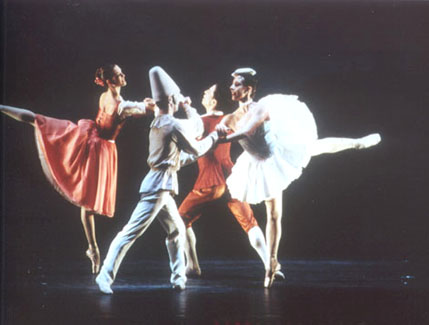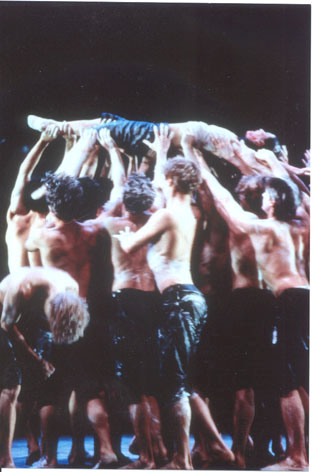|
By Patricia Boccadoro
PARIS,
24 November 2001 - The
Ballet of Zurich opened the new season of dance at the Théatre
de Saint-Quentin-en-Yvelines with a Stravinsky programme. The curtain
rose on Pulcinella, a 1980 work by Heinz Spoerli who was
appointed artistic director of the ufive years ago. Inspired by the
Italian Commedia dell'arte, and incorporating pantomime,
acrobatics and constant misunderstandings between the main characters
throughout, the ballet was only saved by the youthful energy of the
dancers. The average age of the men is twenty-two, and the women
scarcely more.
Francois Petit and Karen Seneca were well
cast in the roles of Pulcinella and Pimpinella respectively. But
despite the fact that it is a purely classical work danced on pointe
which allows the company to demonstrate their high technical level, I
did wonder whether this dated revival was really necessary.

Stravinsky: Pulcinella
Photo: Peter Schnetz
The
second ballet on the programme was a one-act work created by
Balanchine in 1972. The
choreographer had heard Stravinsky's Duo Concertant whilst in
Europe and when writing the lyrical pas de deux, had given pride of
place to the score which he had always said was one of his favourite
pieces of music. Hence the two interpreters, the elegant Lara Radda
and Stanislas Jermakov often pause to better listen to the musicians,
the violinist Ada Pesch, and the pianist Alexey Botvinov, who were
also on stage.
Since
Le sacre du printemps (The Rite of Spring) was first created
by Nijinsky in 1913 and danced by Diaghilev's
Ballets Russes in Paris, I have lost count of the number of
versions around today. The ballet represented a fertility rite in
which a young virgin, The Chosen One, is sacrificed to the arrival of
Spring, and subsequent stagings have more or less followed the same
theme. Spoerli, however, is less concerned with sexuality than with
the suffering of mankind in general and his interpreters seem to be
more the survivors of some kind of nuclear war than members of a
primitive tribe accomplishing their sexual rituals.

Stravinsky:
Le sacre du printemps
Photo: Peter Schnetz
The
stage is sombre, grey. High in the air, an immense darkened beam
crosses the stage horizontally, behind which grains of whitish powder
fall steadily to earth. At first glimpse, it could be a waterfall, but
given the context of the rest of the work, it might also be the
choking dust of the end of time.
Creatures barely human
emerge from some sort of cave, slither down the uneven surface and
unkempt and dishevelled in skimpy black, writhe along the ground. They
are streaked with mud, and as they move rhythmically up and down, they
are joined by their men, bestial, who hurl themselves brutally to
earth. One by one, they go to the growing mound of powder, and cover
their nakedness with the grey-white dust in strict observance of some
pagan rite.
Every movement is in perfect disharmony with
Stravinsky, and disturbs, particularly Yen Han as L'Elu, terror
stricken and caked in grime, with rivulets of blood and sweat
streaming down her face. She is stupendous, as indeed are all the
troupe. Powerful stuff.
Decor and costumes by Florian
Etti.
Lighting by Robertus Cremer.
Patricia
Boccadoro writes on dance in Europe. She contributes to The Guardian,
The Observer and Dancing Times and was dance consultant to the BBC
Omnibus documentary on Rudolf Nureyev. Ms. Boccadoro is the dance editor
for Culturekiosque.com. |
|



